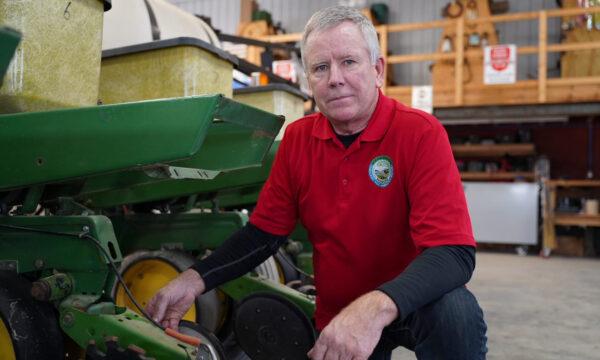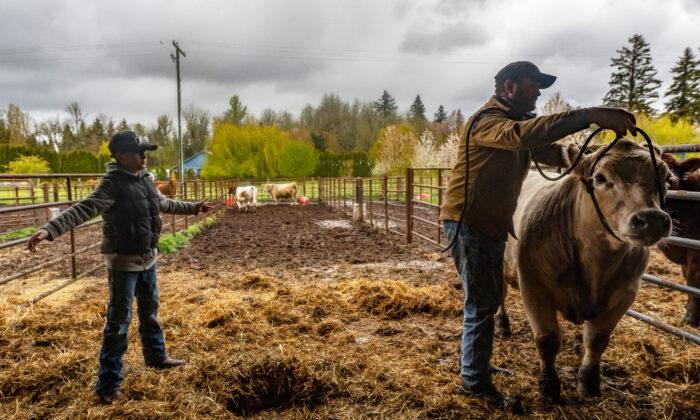It’s no secret that hardworking U.S. farmers are looking to hang up their hats. However, the price of land has left many producers struggling to find successors willing or able to follow in their footsteps.
This is happening against a backdrop of states’ racing to pass new legislation to restrict the foreign purchase of U.S. agricultural land. At the same time, wealthy private investors are grabbing as much as they can.
It’s an alarming situation for many, prompting the question: Who will own the future of U.S. farms?
“It’s getting harder and harder because investors have more money to buy the land versus the farmers,” Tony Peirick told The Epoch Times.
Peirick runs the T&R Dairy Farm in Watertown, Wisconsin. It’s one of those classic American Midwest towns that looks like it was lifted out of a Norman Rockwell painting, surrounded by rolling pasture and cropland. Peirick has seen many changes in the industry over the years; he recalled that he used to carry fresh cows’ milk in buckets as a boy.
“Years ago in our township, I bet we had 15 to 20 dairy farms. Times have changed; there are only three dairy farms now milking cows,” he said.
Peirick said he enjoys the hands-on experience of running a dairy farm and that having a love of farming is essential—particularly in dairy—to be successful because of the job’s demanding nature.
Steep Price Tag
Peirick is one of the lucky ones. The 67-year-old dairy farmer’s sons are willing to take the reins of the family business, which Peirick plans to gift to them.Gifting his sons the land is crucial. Due to the ballooning price of U.S. farmland, it’s the only way they can afford to take the business.
“Back in the ’80s, land was only a thousand dollars an acre and investors weren’t looking at it. Land is more valuable now, up to 10 to 20 thousand dollars an acre just for farmland,” Peirick said.

When coupled with inflated operating costs and supplies, Peirick said producers have a rough road ahead.
“Next-generation farmers will face challenges like land availability and just the cost of material things,” he said.
And even that’s becoming a rich man’s pursuit.
Although $20 doesn’t seem like much, many farms are hundreds or thousands of acres. Peirick’s farm is a 1,100-acre spread; a $20 rent hike on a farm that size would cost $22,000.
“Farming is a capital-intense business with high cost to access new farmland and the equipment needed to farm. This is [the] No. 1 deterrent I’ve witnessed from young or aspiring farmers from getting into farmland,” Mike Downey told The Epoch Times.
Downey is the co-owner of Next Generation Ag Advocates, an Iowa-based service that helps retiring farmers connect with a new generation of producers. With so many farmers getting ready to retire, Downey said he has seen an increase in veteran producers willing to help out new farmers with a gradual ownership transition.
Troubling Numbers
Eighty percent of rented farmland is owned by “non-operator landlords,” according to the USDA. That means 30 percent of all U.S. agricultural land is owned by companies or people who aren’t farmers.It’s a trend Downey has seen in Iowa, where he said that about one-third of all land is owned by people who aren’t operators or have no farm experience.
“I believe we, as an [agriculture] industry, need to do a better job educating new owners about the responsibilities that come with land ownership,” he said.
When it comes to nonoperators owning farmland, the writing has been on the wall for years.
When Bill Gates became the largest private owner of U.S. agricultural land in 2018, the world sat up and took notice. Headlines of the Microsoft co-founder’s acquisitions—more than a quarter million acres—triggered alarm over how wealthy private investment could affect the U.S. food supply chain.

But America had already been losing crop and pasture land to nonfarming interests for years.
One 2020 analysis shows that the United States lost 11 million acres of farmland over the past 20 years.
For Downey, the shift toward nonproducer land ownership and big private investment is a more significant concern than aging producers.
“I’m more concerned about what motives foreign buyers or larger institutional groups have for buying farmland, as it related to future food production,” he said.
Peirick said he shared this sentiment. Because at the end of the day, whoever holds the land holds all the cards.
Words of Wisdom
Even optimistic estimates of the number of aging farmers who have identified successors are bleak. These figures range from 30 percent on the low end to less than 70 percent in the best-case scenario.It’s part of what drives Downey and his team to help connect the new generation of producers during this critical changing of the guard.
“Our first priority is to make sure we are identifying all parties’ goals, so we are matching up like-minded individuals and philosophies for farming,” he said.
For Peirick, it all comes back to having a passion for working with the land. Because farming is a high-cost and challenging industry.
“It is labor-intensive, and it’s hard to find people to do the hand labor,” he said.
When asked whether he had any words of wisdom to impart to future farmers, Peirick didn’t mince words: “The next generation of farmers needs to be passionate. ... The net income will be getting tight, so you have to enjoy what you’re doing because you’re not going to make a lot of income.”





